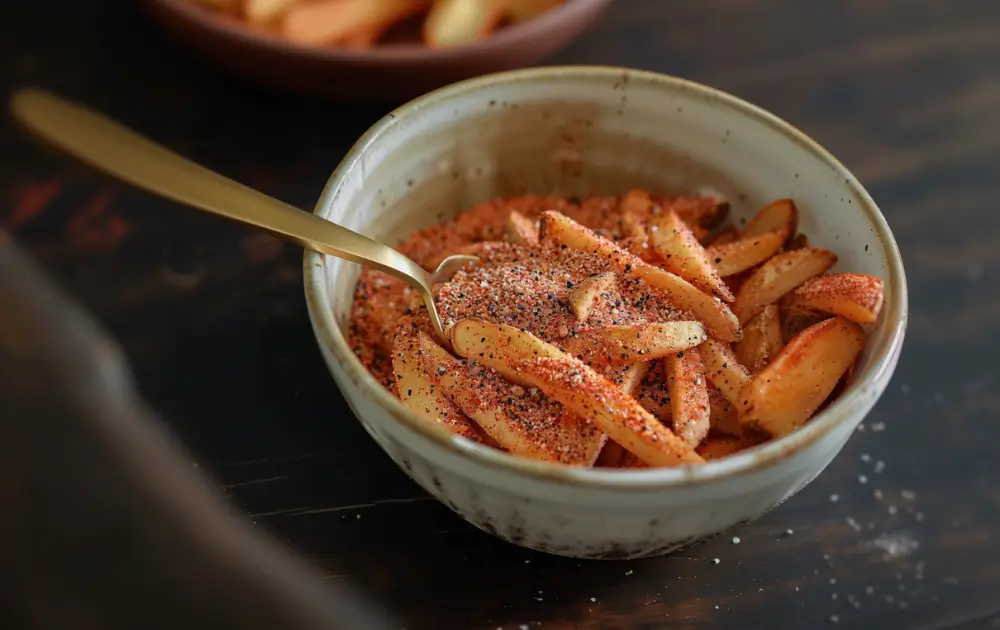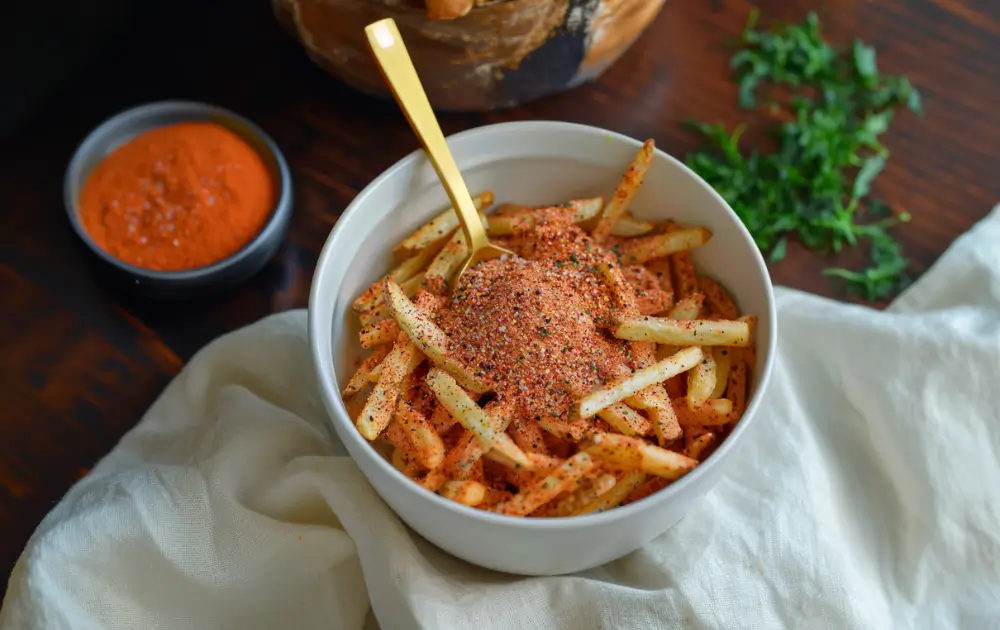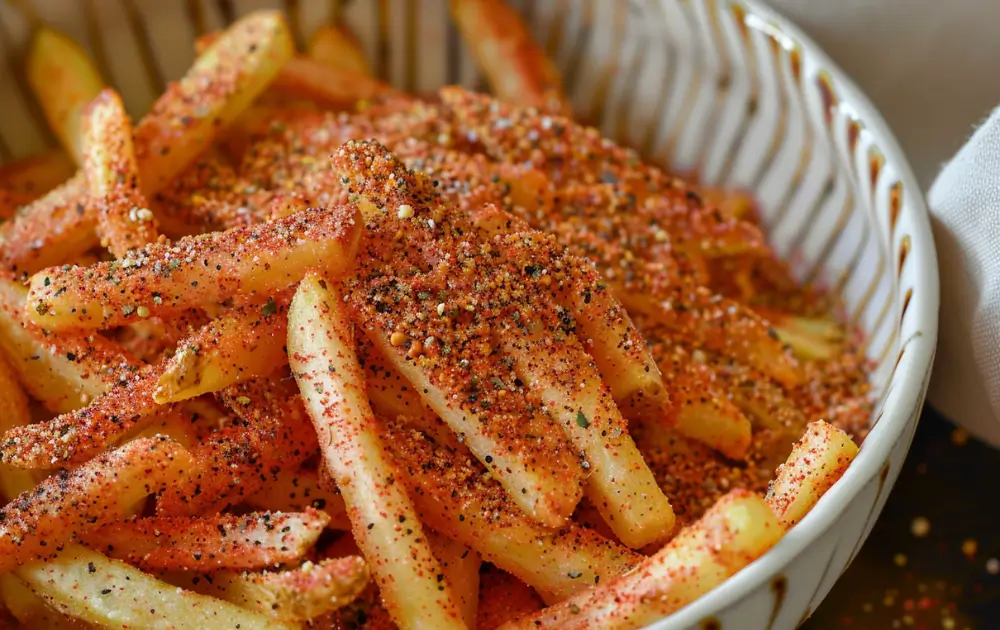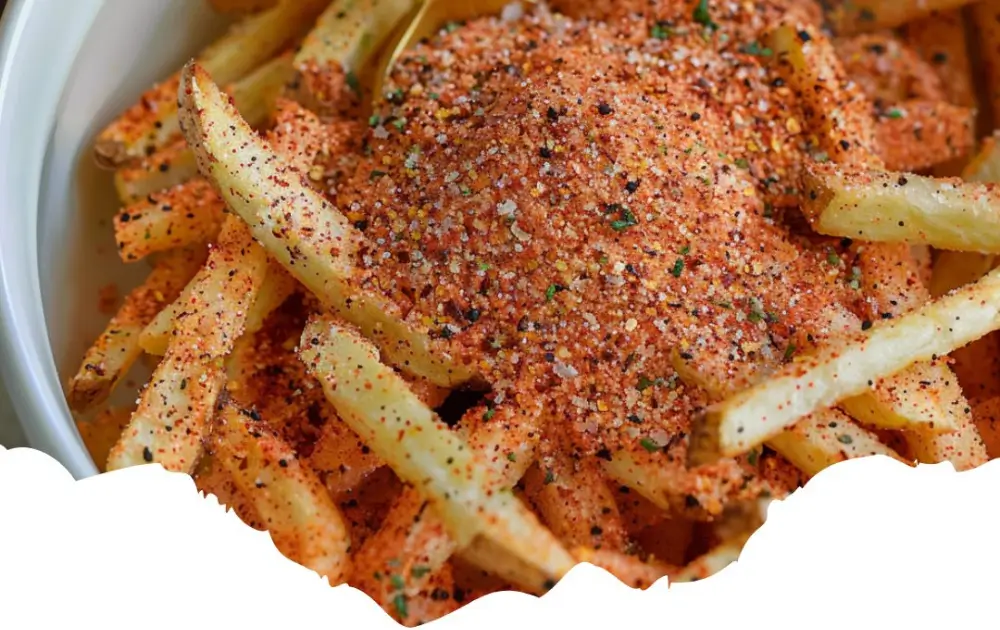Introduction to French Fry Seasoning
French Fry Seasoning is what elevates good fries to great ones, bringing an explosion of flavors that enhance the natural taste of potatoes. Whether you prefer your fries baked, fried, or air-fried, the right seasoning can make all the difference. From simple salt and pepper to more elaborate spice blends incorporating herbs and heat, there’s a vast array of options to satisfy any palate. This article explores various seasoning mixes that can be easily made at home to boost your french fry game.
Print
French Fry Seasoning
- Total Time: 5 minutes
- Yield: 1/4 cup
- Diet: Gluten Free
Description
Enhance the flavor of your homemade French fries with this easy and versatile French Fry Seasoning. This blend combines spices and herbs to create a savory mix that adds the perfect kick to any type of fried or baked potato.
Ingredients
Instructions
Notes
- Adjust the amount of cayenne pepper based on your desired spice level or omit it for a milder flavor.
- This seasoning can also be used on other dishes such as roasted vegetables, popcorn, or grilled meats.
- Prep Time: 5 minutes
- Category: Condiment
- Method: Mixing Cuisine
- Cuisine: American
Nutrition
- Calories: 5
- Sugar: 0g
- Fat: 0g
- Carbohydrates: 1g
- Cholesterol: 0mg
Frequently Asked Questions (FAQs)
What is the best way to store homemade French fry seasoning?
Store your homemade French fry seasoning in an airtight container in a cool, dry place. This helps to maintain the freshness and potency of the spices for longer periods. Glass jars with tight-sealing lids are ideal for this purpose.
Can I make large batches of French fry seasoning in advance?
Yes, you can make large batches of French fry seasoning in advance. Preparing in bulk can save time and ensure you always have your favorite blend on hand. Just remember to store it properly to preserve its flavor and freshness.
How can I adjust the spiciness of my French fry sea
soning?
Adjust the spiciness of your French fry seasoning by increasing or decreasing the amount of heat-based spices like cayenne pepper or chili powder. Start with small increments to find the right balance that suits your taste preferences.
Are there any substitutes for salt in French fry seasonings?
For a lower sodium option, you can use a salt substitute or reduce the amount of salt and increase other spices and herbs to compensate for flavor. Ingredients like onion powder, garlic powder, and dried herbs can help enhance the taste without adding extra sodium.
How long does homemade French fry seasoning last?
Homemade French fry seasoning can last up to 6 months when stored correctly in an airtight container and in a cool, dry place. However, for the best flavor, try to use it within the first three months after making it.
Basic Ingredients for French Fry Seasoning
The foundation of any good french fry seasoning starts with salt. Kosher salt or sea salt is often preferred for its pure taste and the way it clings to the fries. Black pepper adds a simple but necessary piquancy, complementing the earthy potato flavor. For those who enjoy a bit of heat, adding paprika not only brings a gentle warmth but also gives the fries a vibrant color. Garlic powder and onion powder are common additions, providing a depth of flavor that makes the fries irresistible.
Creative Spice Blends
To create a unique french fry seasoning, consider mixing traditional spices with more unexpected ingredients. A Cajun-inspired blend can be made with cayenne pepper, thyme, and a hint of oregano for some Southern flair. For a sweeter take, mixing cinnamon with a small amount of sugar can offer a delightful contrast to the savory notes. Adding dried herbs like rosemary or thyme introduces a Mediterranean twist, perfect for pairing with artisanal burgers or gourmet sandwiches.
International Flavors
Exploring international flavors can turn ordinary french fries into a global culinary adventure. Try a Mexican blend with chili powder, cumin, and a dash of lime zest for fries that pack a zesty punch. An Indian version might include curry powder, turmeric, and a bit of ginger for a spicy-savory mix that’s great with grilled meats or seafood. For an Asian touch, blending sesame seeds, wasabi powder, and a small amount of sugar can create a distinctly bold topping for your fries.
Application Techniques
Applying seasoning to french fries is an art in itself. For optimal flavor, season the fries while they are still hot and fresh out of the oven or fryer, as this helps the seasoning stick better. A shaker or a small sieve can be used to evenly distribute the seasoning over the fries. For an even coating, you can toss the fries and seasoning in a large bowl or a paper bag. This ensures every fry is perfectly seasoned, offering a consistent taste in every bite.

Health-Conscious Seasoning Options
For those looking to enjoy French fries without the guilt, there are numerous health-conscious seasoning alternatives. Opting for salt substitutes or reducing the salt content and increasing herbs and spices like garlic, pepper, and paprika can enhance flavor without adding sodium. Nutritional yeast can be sprinkled on fries for a cheesy flavor without the dairy or excess calories. Utilizing natural spice blends without added sugars or preservatives can also help maintain a healthier diet while still indulging in deliciously seasoned fries.
DIY Seasoning Mixes
Creating your own DIY French fry seasoning mix allows for customization to suit personal taste preferences and dietary needs. Start with a base of salt and pepper, then add your choice of spices such as smoked paprika, dried mustard, or celery salt for complexity. Store these mixes in airtight containers, and label them with the ingredients and date made for future use. Making seasoning in bulk not only saves time but ensures you always have your favorite flavors on hand for impromptu fry-making sessions.
Enhancing Sweet Potato Fries
Sweet potato fries are a popular alternative to traditional fries and pair well with both sweet and savory seasonings. A mix of brown sugar and cinnamon complements the natural sweetness of the potatoes, while a spicy blend of chipotle powder and garlic can offer a smoky contrast. Experimenting with different herbs and spices, like nutmeg or thyme, can turn sweet potato fries into a gourmet side dish or a tasty snack that stands out from the usual fare.
Seasoning Storage and Shelf Life
Proper storage of French fry seasoning is crucial for maintaining its potency and flavor. Keep your seasoning blends in a cool, dry place away from direct sunlight to prevent degradation of the spices. Mason jars with tight-fitting lids or spice containers with moisture-proof seals are ideal for storage. Typically, homemade spice mixes can last up to six months when stored properly. However, for the best flavor, it is recommended to use them within three months.
Pairing Seasonings with Dipping Sauces
To further enhance your French fry experience, pair your seasoned fries with complementary dipping sauces. For example, fries seasoned with a simple salt and pepper blend might pair well with classic ketchup or mayonnaise. More exotic seasonings, like those with curry powder or cumin, could be enhanced by dipping them in a cooling yogurt or cucumber sauce. Experimenting with different combinations of seasonings and sauces can turn even a basic batch of fries into a memorable culinary adventure.
Special Event and Party Ideas
French fries with unique seasonings can be a standout feature at any gathering or special event. Consider setting up a “fry bar” where guests can choose from a variety of seasoning mixes and sauces to customize their fries. Offer options like truffle salt, Parmesan garlic, spicy Cajun, or herbes de Provence for a gourmet touch. This interactive element not only adds fun to the dining experience but also allows guests to experiment with flavors they might not typically try. Label each seasoning clearly and provide suggestions for pairing to enhance the guest experience.
Reducing Waste with Homemade Seasonings
Creating your own French fry seasonings can be a great way to reduce waste in the kitchen. Utilize spices and herbs that are nearing the end of their shelf life to make fresh, homemade mixes. This not only prevents waste but also provides a more flavorful alternative to store-bought seasonings, which can contain fillers and artificial ingredients. Collecting and using leftover spices from other cooking projects encourages a more sustainable cooking practice and maximizes the value of your pantry items.
Educational Cooking Classes
Hosting cooking classes focused on making French fry seasonings can be an engaging way to teach culinary skills and spice knowledge. Participants can learn about the origins of different spices, their health benefits, and how to blend them for optimal flavor. These classes could include lessons on matching seasonings with specific types of fries, such as traditional russet potatoes, sweet potatoes, or even alternative vegetables like zucchini and carrots. Offering these educational experiences can inspire healthier eating habits and creative cooking at home.
Incorporating Seasonal Spices
Seasonal spices can provide a timely and festive twist to French fry seasonings. For autumn, consider blends featuring pumpkin spice or cinnamon. During the holiday season, a mix of nutmeg, star anise, and clove can offer a warm, festive flavor. Spring might call for lighter, more floral spices such as lavender or lemon pepper. Utilizing seasonal spices not only makes the fries feel special and time-appropriate but also takes advantage of the peak flavors of these ingredients.
Marketing Your Homemade Seasonings
If your French fry seasonings are a hit, consider packaging and selling them as part of a small home-based business or at local markets. Design attractive labels and offer samples to intrigue potential buyers. Create gift sets of your most popular seasoning mixes for holidays, special occasions, or as part of a subscription box service. Marketing these unique blends can turn a passion for flavors into a profitable venture, especially if you focus on organic, locally-sourced, or hard-to-find ingredients that appeal to gourmet food enthusiasts.

Tips for Achieving Consistent Quality
To ensure consistent quality in your French fry seasonings, it’s crucial to source high-quality spices. Fresh, premium spices will provide more vibrant flavors and aromas than their older, stale counterparts. Purchasing whole spices and grinding them yourself before making a seasoning mix can also make a significant difference in the intensity of the flavors. Additionally, testing your blends on different types of fries can help you adjust the amounts and ratios of spices to achieve the perfect balance for various potato types and cooking methods.
Experimenting with Global Flavors
Broaden your culinary horizons by experimenting with French fry seasonings inspired by global cuisines. For instance, incorporate spices commonly used in African dishes, such as berbere or ras el hanout, for a unique and complex flavor profile. Experimenting with Japanese ingredients like nori or wasabi powder can add an unexpected twist to your fries. This approach not only makes your offerings more interesting but also caters to adventurous eaters looking to try new and exciting flavors.
Engaging Community Through Workshops
Organizing workshops where community members can come together to learn about and create their own French fry seasonings can foster a sense of community and share culinary culture. These events can serve as great opportunities for people to interact, exchange ideas, and enjoy homemade fries. Workshops can be themed around specific cuisines or focused on teaching about the health benefits of various herbs and spices, adding educational value to the fun culinary activity.
Leveraging Social Media for Promotion
Use social media platforms to promote your French fry seasonings effectively. Share engaging content such as recipe videos, customer reviews, and behind-the-scenes looks at how you make your blends. Running promotions or contests where followers can win a sample pack of your seasonings can increase engagement and brand visibility. Utilizing hashtags related to cooking, foodies, and homemade spices can help reach a wider audience who are interested in enhancing their kitchen pantry.
Sustainability in Spice Usage
Emphasize sustainability in your spice usage by sourcing ingredients from fair-trade and organic suppliers. This not only improves the quality of your product but also supports ethical farming practices. Educate your customers about the benefits of sustainable spice consumption through your marketing materials and social media channels. Offering refills in environmentally friendly packaging can further appeal to eco-conscious consumers, reinforcing your brand’s commitment to sustainability and responsible culinary practices.

Quality Control in Spice Blending
Maintaining a high standard in spice blending requires meticulous quality control. Implementing a routine to check the freshness and potency of spices before use is crucial. Create a system where spices are regularly tested for flavor and aroma after a set period in storage, ensuring they meet your standards before they are blended into your seasonings. Keeping detailed records of spice sources, purchase dates, and test results can help manage this process effectively, guaranteeing that only the best ingredients are used in your seasonings.
Customizable Seasoning Kits
Offering customizable seasoning kits can cater to customers who enjoy personalized flavors. These kits can include a base seasoning blend with optional add-on spices that customers can mix and match according to their taste preferences. Providing recipes and mixing instructions with these kits not only enhances the user experience but also encourages creativity in the kitchen. This approach allows individuals to feel more connected to the cooking process and more satisfied with the end product.
Educational Content on Spice Benefits
To add value to your seasoning offerings, include educational content that highlights the health benefits and culinary uses of specific spices. Creating informative blog posts, newsletters, or social media content about how spices can enhance not just the flavor but also the nutritional value of meals can engage and inform your audience. Such content can position your brand as a thought leader in the culinary space, building trust and loyalty among your customer base.
Seasonal and Holiday Specials
Develop seasonal and holiday-specific French fry seasoning blends to tap into the festive market. For example, introduce a special pumpkin spice blend for autumn, a peppermint patty blend for the winter holidays, or a floral-infused mix for spring. These limited-time offers can generate excitement and increase sales during key shopping periods. Additionally, creating attractive packaging for these special editions can make them appealing as gifts, further expanding your market.
Expanding Your Product Line
Consider expanding your product line beyond French fry seasonings to include other types of culinary spices and blends. By leveraging the brand reputation you’ve built with your initial products, you can introduce new items like marinades, rubs, or even baking spices. Offering a wider range of products can attract a broader audience and increase the purchasing options for existing customers, potentially increasing overall sales and enhancing brand loyalty.

Conclusion
Homemade French fry seasoning is a simple and effective way to elevate your culinary creations, bringing personalized flavor to one of the world’s most beloved side dishes. By selecting high-quality spices, storing them properly, and experimenting with different flavor combinations, you can craft seasonings that not only enhance the taste of French fries but also offer versatility in various dishes. Whether you’re cooking for yourself, family, or guests, homemade seasoning mixes provide an opportunity to showcase your culinary skills and impress with every meal.

